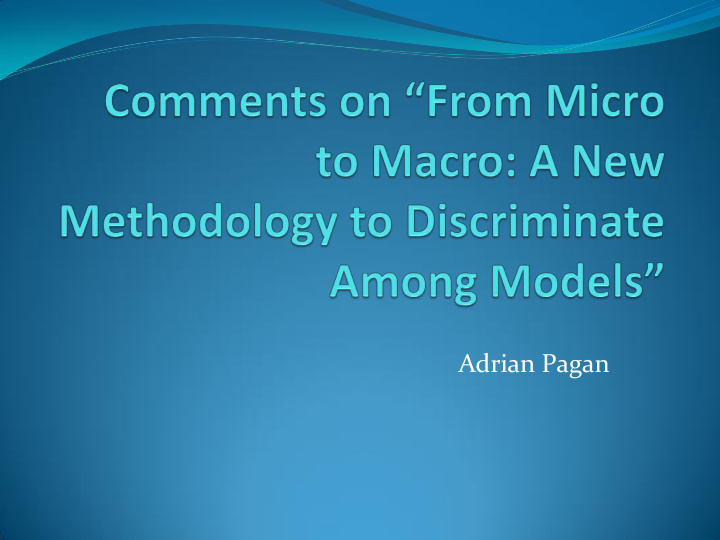



Adrian Pagan
The Objective The paper wants to make a choice between two micro pricing models - menu cost and Calvo Use evidence on this that doesn’t just doesn’t come from micro data A challenge for traditional menu cost models is that prices adjust only after a threshold is passed This means that we would not observe many small price changes In the data there are a lot of these and they produce leptokurtosis. Rather similar to stock returns.
Modifying the Model Model used here has a free adjustment cost opportunity coming to firms at a certain probability So it this which allows the menu cost model to produce leptokurtosis One might think that one could just compute the densities of price changes from the two models and then see what they each predict about the density around zero Alternatively one might look at the index of kurtosis in the data and from the models One problem with that is kurtosis might reflect fat tails
Macro data to Discriminate Between the Models Paper argues that it is frequency of change that is important to assess the models, not the degree of kurtosis as argued by Alvarez et al Find median frequency of price changes by industry and then concentrate on above median “high frequency” and below median “low frequency” industries Using industry data they find impulse responses of inflation to monetary shocks with a monthly FAVAR system and narrative methods from 1969-2007 These are then cumulated to measure yearly inflation rates to a shock for each of the high and low frequency “industries”
Results from FAVAR? Find that for a 25 basis point decline in interest rates the cumulated change in the price level is 15 basis points for high frequency and 5 basis points for low frequency. There is no difference between impulse responses for the cut between high and low kurtosis industries So this seems to be useful evidence for testing the models We are talking here about the cumulative impact of a monetary shock for 1 year. This seems very small to me. And this is for the high frequency industries. Low only have 5 basis points. Moreover is the difference of 10 basis points really important? No standard errors (they have some in UVW slides but I am uncertain of how these are computed) Calibrate the parameters of the two models using average micro data from all the industries that are > high and < low frequency cut offs. They then find that the Calvo model does better at producing the above results
Permanent and Transitory Effects In the micro models nominal shocks have permanent effects on prices In FAVAR etc this is also true because the factors are combinations of inflation rates and other variables (to form the PCs) The problem with this is that one also has variables like growth of output in the data set and so monetary shocks have a permanent effect on the level of output This doesn’t seem satisfactory (the micro models don’t have it) but is a problem with using differenced variables and interest rates or shocks Might be o.k. if one uses nominal growth rates for real variables Otherwise one needs to separate the nominal and real variables when computing factors
The Narrative Approach Narrative approach is model free Essentially regresses industry inflation q(t) against q(t-1) and monetary shock ε (t) Problem is whether something else affects industry inflation besides monetary shocks One would think so So mis-specified equation as missing terms are in the error (they do have seasonal effects accounted for) May not affect coefficient on ε (t) but should affect that on q(t-1) So impulse responses are affected.
The Model Calibrate model using industry statistics Not quite sure what they used as the micro moments - sales? Estimated menu cost model says that kurtosis is important for cumulative shocks Data shows it isn’t One would need to change the calibrated model coefficients to match the macro moments and they show how much that would need to be. Good idea. The micro model looks rather simple to me and one wonders how robust this outcome would be to a more complex model of pricing and output (nominal demand is exogenous so no monetary rule of the type used in the FAVAR/Narrative facts)
Conclusions The idea is good. I am not sure that the impulse responses are estimated properly (FAVAR issue) and it is important that the differences according to the data split are estimated well I thought the 15 basis point cumulative responses of prices to monetary shocks were too low based on macro work I feel that a problem with the micro models is that they don’t really embed in a macro context – sales are I(1) exogenous processes in aggregate. So I was a bit nervous about using macro data to test then I haven’t looked at this literature much so I quite liked reading up on it
Recommend
More recommend